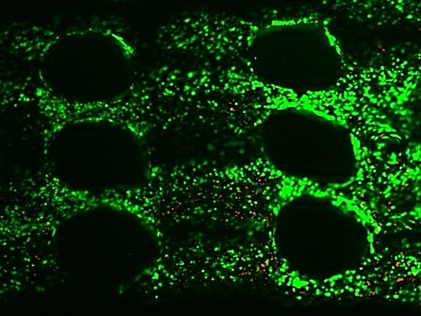Ruthenium Photocrosslinking for Silk Bioprinting
02/25/20
Publication Title:
Rapid Photocrosslinking of Silk Hydrogels with High Cell Density and Enhanced Shape Fidelity
Advanced BioMatrix Products Used:
Ruthenium Photoinitiator
How the products were used:
Silk Fibroin was 3D bioprinted with high shape fidelity using rapid photocrosslinking with the photoinitiator Ruthenium and visible light (400-450nm)



Article Abstract:
Silk fibroin hydrogels crosslinked through di‐tyrosine bonds are clear, elastomeric constructs with immense potential in regenerative medicine applications. In this study, demonstrated is a new visible light‐mediated photoredox system for di‐tyrosine bond formation in silk fibroin that overcomes major limitations of current conventional enzymatic‐based crosslinking. This photomediated system rapidly crosslinks silk fibroin (<1 min), allowing encapsulation of cells at significantly higher cell densities (15 million cells mL−1) while retaining high cell viability (>80%).
The photocrosslinked silk hydrogels present more stable mechanical properties which do not undergo spontaneous transition to stiff, β‐sheet‐rich networks typically seen for enzymatically crosslinked systems. These hydrogels also support long‐term culture of human articular chondrocytes, with excellent cartilage tissue formation. This system also facilitates the first demonstration of biofabrication of silk fibroin constructs in the absence of chemical modification of the protein structure or rheological additives. Cell‐laden constructs with complex, ordered, graduated architectures, and high resolution (40 µm) are fabricated using the photocrosslinking system, which cannot be achieved using the enzymatic crosslinking system.
Taken together, this work demonstrates the immense potential of a new crosslinking approach for fabrication of elastomeric silk hydrogels with applications in biofabrication and tissue regeneration.
Link to the publication:
https://onlinelibrary.wiley.com/doi/abs/10.1002/adhm.201901667



